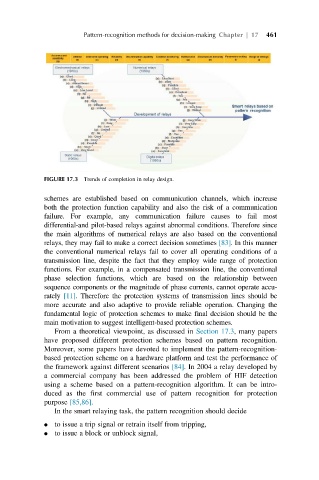Page 501 - Decision Making Applications in Modern Power Systems
P. 501
Pattern-recognition methods for decision-making Chapter | 17 461
FIGURE 17.3 Trends of completion in relay design.
schemes are established based on communication channels, which increase
both the protection function capability and also the risk of a communication
failure. For example, any communication failure causes to fail most
differential-and pilot-based relays against abnormal conditions. Therefore since
the main algorithms of numerical relays are also based on the conventional
relays, they may fail to make a correct decision sometimes [83]. In this manner
the conventional numerical relays fail to cover all operating conditions of a
transmission line, despite the fact that they employ wide range of protection
functions. For example, in a compensated transmission line, the conventional
phase selection functions, which are based on the relationship between
sequence components or the magnitude of phase currents, cannot operate accu-
rately [11]. Therefore the protection systems of transmission lines should be
more accurate and also adaptive to provide reliable operation. Changing the
fundamental logic of protection schemes to make final decision should be the
main motivation to suggest intelligent-based protection schemes.
From a theoretical viewpoint, as discussed in Section 17.3, many papers
have proposed different protection schemes based on pattern recognition.
Moreover, some papers have devoted to implement the pattern-recognition-
based protection scheme on a hardware platform and test the performance of
the framework against different scenarios [84]. In 2004 a relay developed by
a commercial company has been addressed the problem of HIF detection
using a scheme based on a pattern-recognition algorithm. It can be intro-
duced as the first commercial use of pattern recognition for protection
purpose [85,86].
In the smart relaying task, the pattern recognition should decide
to issue a trip signal or retrain itself from tripping,
to issue a block or unblock signal,

